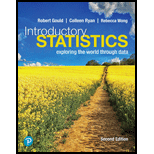
Anesthesia Care and Adverse Postoperative Outcomes Handing over the care of a patient from one anesthesiologist to another occurs during some surgeries. A study was conducted to determine if this transfer of care might increase the risk of adverse outcomes (Jones et al. 2018). Read the excerpt from the study abstract published in JAMA below and answer the questions that follow.
Methods: A retrospective population-based cohort study was conducted of adult patients undergoing major surgeries expected to last at least two hours and requiring a hospital stay of at least one night. The pri-mary outcome measured was a composite of all-cause death, hospital readmission or major postoperative complications all within 30 postoperative days.
Results: A total of 5941 patients underwent surgery with complete handover of anesthesia care. The primary outcome (death, readmission, or major postoperative complications) occurred in 2614 of these patients. A total of 307,125 patients underwent surgery without complete handover of anesthesia care. Of these, the primary outcome occurred in 89,066 patients. The complete handovers were statistically significantly associated with an increased risk of the primary outcome ([95% CI, 4.5% to 9.1%];
a. Compare the percentage of each group who experienced the primary outcome (death, readmission, or major postoperative complications). Based on the abstract, can you reject the null hypothesis that there is no difference in the rates of primary outcome?
b. If you were a hospital administrator, would you recommend that complete handover of anesthesia care during operations be limited? Why or why not?
c. A difference between the two groups was found for all of the primary care outcomes except hospital readmission within 30 days of surgery. How do the confidence interval and p-values provided support this conclusion?
Want to see the full answer?
Check out a sample textbook solution
Chapter 12 Solutions
INTRODUCTORY STATISTICS (LOOSELEAF)
- A marketing agency wants to determine whether different advertising platforms generate significantly different levels of customer engagement. The agency measures the average number of daily clicks on ads for three platforms: Social Media, Search Engines, and Email Campaigns. The agency collects data on daily clicks for each platform over a 10-day period and wants to test whether there is a statistically significant difference in the mean number of daily clicks among these platforms. Conduct ANOVA test. You can provide your answer by inserting a text box and the answer must include: also please provide a step by on getting the answers in excel Null hypothesis, Alternative hypothesis, Show answer (output table/summary table), and Conclusion based on the P value.arrow_forwardA company found that the daily sales revenue of its flagship product follows a normal distribution with a mean of $4500 and a standard deviation of $450. The company defines a "high-sales day" that is, any day with sales exceeding $4800. please provide a step by step on how to get the answers Q: What percentage of days can the company expect to have "high-sales days" or sales greater than $4800? Q: What is the sales revenue threshold for the bottom 10% of days? (please note that 10% refers to the probability/area under bell curve towards the lower tail of bell curve) Provide answers in the yellow cellsarrow_forwardBusiness Discussarrow_forward
- The following data represent total ventilation measured in liters of air per minute per square meter of body area for two independent (and randomly chosen) samples. Analyze these data using the appropriate non-parametric hypothesis testarrow_forwardeach column represents before & after measurements on the same individual. Analyze with the appropriate non-parametric hypothesis test for a paired design.arrow_forwardShould you be confident in applying your regression equation to estimate the heart rate of a python at 35°C? Why or why not?arrow_forward
 Glencoe Algebra 1, Student Edition, 9780079039897...AlgebraISBN:9780079039897Author:CarterPublisher:McGraw Hill
Glencoe Algebra 1, Student Edition, 9780079039897...AlgebraISBN:9780079039897Author:CarterPublisher:McGraw Hill
 Big Ideas Math A Bridge To Success Algebra 1: Stu...AlgebraISBN:9781680331141Author:HOUGHTON MIFFLIN HARCOURTPublisher:Houghton Mifflin Harcourt
Big Ideas Math A Bridge To Success Algebra 1: Stu...AlgebraISBN:9781680331141Author:HOUGHTON MIFFLIN HARCOURTPublisher:Houghton Mifflin Harcourt College Algebra (MindTap Course List)AlgebraISBN:9781305652231Author:R. David Gustafson, Jeff HughesPublisher:Cengage Learning
College Algebra (MindTap Course List)AlgebraISBN:9781305652231Author:R. David Gustafson, Jeff HughesPublisher:Cengage Learning Holt Mcdougal Larson Pre-algebra: Student Edition...AlgebraISBN:9780547587776Author:HOLT MCDOUGALPublisher:HOLT MCDOUGAL
Holt Mcdougal Larson Pre-algebra: Student Edition...AlgebraISBN:9780547587776Author:HOLT MCDOUGALPublisher:HOLT MCDOUGAL




